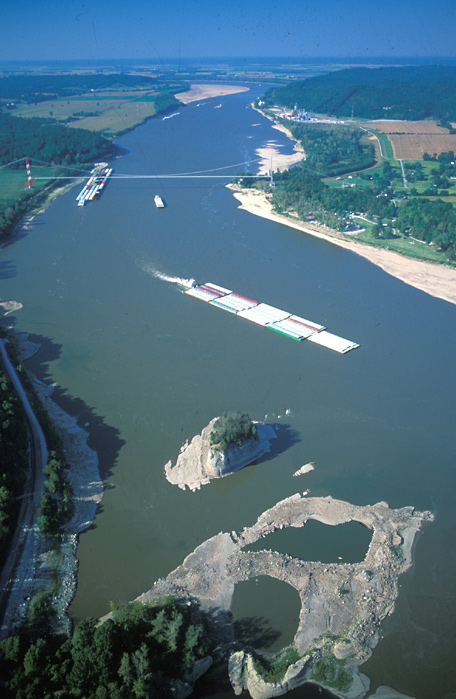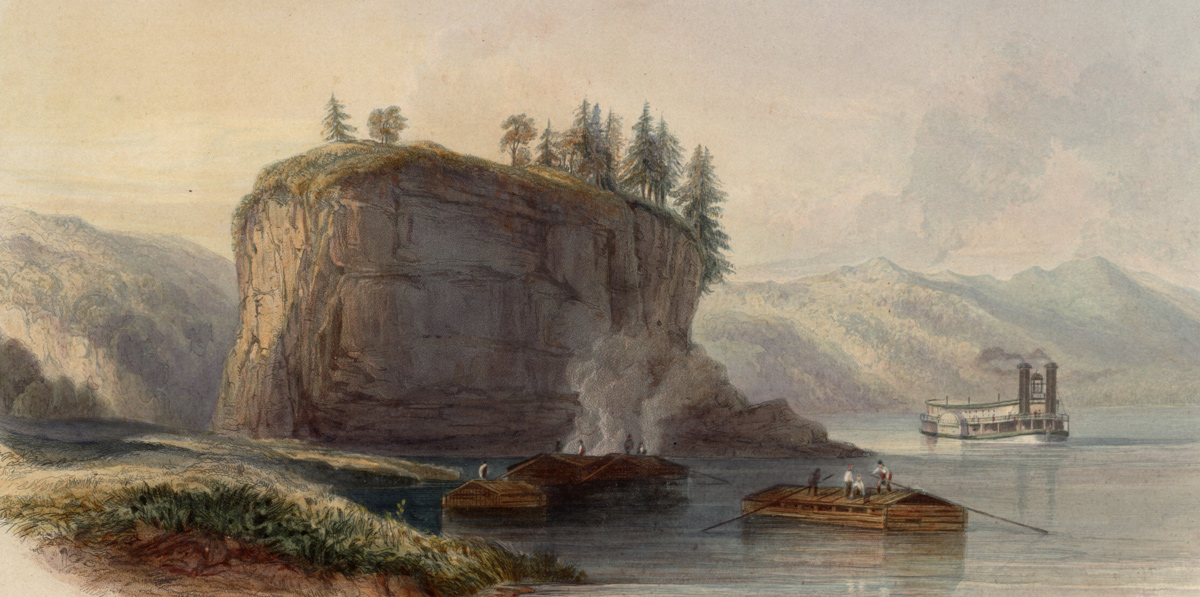On 25 November 1803 Lewis wrote, “Arrived at the Grand Tower a little before sunset, passed above it and came too on the Lard. [left] shore for the night.” He was referring to the tree-capped island just below the center of the photo. In 1673 French explorers Père Marquette and Louis Joliet listened to local Indians’ warnings about this place and erected a cross atop the ninety-foot-high rock to disempower the demons said to be lurking in the treacherous whirlpool at its base. Lewis explained: “This seems among the watermen of the Mississippi to be what the . . . Equinoxial line is with regard to the Sailors; those who have never passed it before are always compelled to pay or furnish some sperits to drink or be ducked.”
In fact, the river around the Grand Tower can be devilishly dangerous, as Lewis was told: “When the river is high the courent setts in with great violence . . . this courent meets the other portion of the river which runs E. of the Tower. . .; these strong courants thus meeting each other form an immence and dangerous whirlpool which no boat dare approach. . .; the counter courent driving with grat force against the E. side of the rock would instantly dash them to attoms and the whirlpool would as quickly take them to the bottom.” Lewis was informed that “in the present state of the water there is no danger in approaching it.” Indeed, every few years, when the water is low it is possible to walk to the Grand Tower or Tower Rock on dry sand, but when the Mississippi is high, even modern towboat pilots shy away from it.
After the Civil War, when the Corps of Engineers intensified channelization work on the Mississippi, clearing rocks, shoals, snags and other impediments to safe river commerce, Tower Rock was left standing as a footing for a proposed railroad bridge. The bridge was never built; Tower Rock is now a National Historic Site.
“Attoms”
Water-Level View
Karl Bodmer (1809–1893)
Rare Book and Special Collections Division, Library of Congress.
Karl Bodmer’s aquatint of the rock based on a sketch he made in 1833, when he accompanied Prince Maximilian von Wied into the far American West.[1]Voyage dans l’intérieur de l’Amérique du Nord, exécuté pendant les années 1832, 1833 et 1834, par le prince Maximilien de Wied-Neuwied (Paris: A Bertrand, 1840-43), Vignette 9. The box-shaped boats in the foreground are flatboats, sometimes called arks, New Orleans boats, Kentucky boats, broadhorses, broadbeams, sneak boxes, or rafts. Lacking keels and sails, and guided by long oars called sweeps, they were used for down-river travel during high water. Though they had average capacities of 30 or 40 tons of cargo, they cost no more than $50 or $60 to build, and at the end of the float could be sold for the value of the lumber.[2]Eric F. Haites, James Mak, and Gary M. Walton, Western River Transportation: The Era of Early Internal Development, 1810-1860 (Baltimore: Johns Hopkins University Press, 1975), 14-15. Leland D. … Continue reading The wisps of smoke rising from the far side of the group of boats at center may be from on-board cooking fires.
What might Lewis have known of “attoms”? Democritus (460—370 B.C.), applied the word atomon, meaning “indivisible,” to the smallest, full, and incompressible particles of matter. His philosophical theory survived intact for more than two thousand years, until inquirers in Italy, France, and England conducted the first experiments with chemical compounds and reactions that led to the science called atomic chemistry, and the British chemist and physicist John Dalton published his New system of Chemical Philosophy in 1808–1810. Americans such as Samuel Latham Mitchill of Columbia University were assimilating European theories, too. Jefferson would have known of all this, but he was opposed to a too-rapid proliferation of scientific theories and vocabularies. Consequently, Lewis probably would have used the word atom in its ancient and then-still-accepted philosophical sense, which was reduced by Noah Webster, in his Compendious Dictionary of the English Language of 1806, to a five-word definition: “matter, an extreme small particle.”
From Discovering Lewis & Clark from the Air
Photography by Jim Wark
Text by Joseph Mussulman
Reproduced by permission of Mountain Press
Notes
| ↑1 | Voyage dans l’intérieur de l’Amérique du Nord, exécuté pendant les années 1832, 1833 et 1834, par le prince Maximilien de Wied-Neuwied (Paris: A Bertrand, 1840-43), Vignette 9. |
|---|---|
| ↑2 | Eric F. Haites, James Mak, and Gary M. Walton, Western River Transportation: The Era of Early Internal Development, 1810-1860 (Baltimore: Johns Hopkins University Press, 1975), 14-15. Leland D. Baldwin, The Keelboat Age on Western Waters, (Pittsburgh: University of Pittsburgh Press, 1941), 47-48. |


